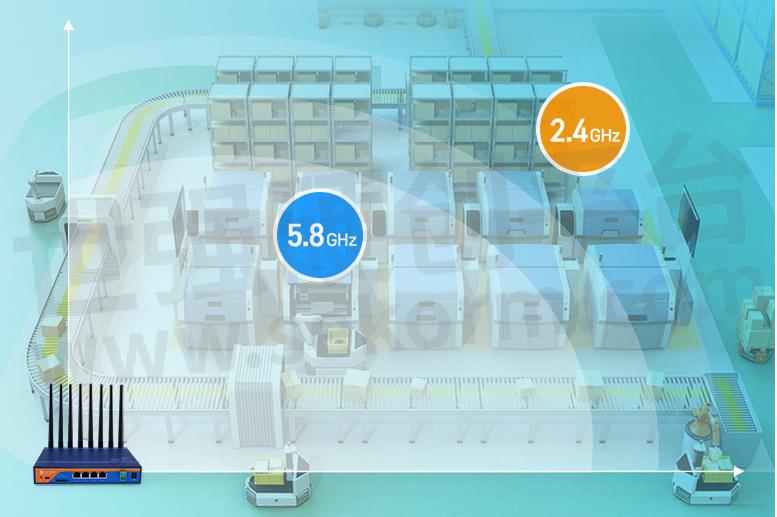Reasons for Anti-interference of 5G Industrial Routers

With the further development of the world in the direction of intellectualization, the whole social ecosystem is becoming more and more dependent on the Internet of Things technology and communication technology. Industrial Router, as a path channel connecting different networks, provides more solid and stable network transmission signals for various fields through the integration and development of 5G technology. Nowadays, Industrial Router has been widely used in smart grid, smart transportation, smart home, smart building, and other fields. It is divided into 2.4G and 5G modes in the connection frequency band. So how should we distinguish between a 2.4G Industrial Router and a 5G Industrial Router? What are the features of the 5G Industrial Router?
Comparison of 4G and 5G:
Advantages of 4G: long transmission distance, strong anti-attenuation ability, and good ability to penetrate walls. The disadvantage is that the free frequency band in the industrial, scientific, and medical fields is used by many devices in life, such as Bluetooth, microwave ovens, remote controls, etc., which leads to the congestion of 2.4G channels.
Advantages of 5G: larger bandwidth, enhanced data throughput, less interference to the 5G band, and faster transmission speed. Disadvantages: poor penetration, short coverage distance, most smart devices still support 2.4G, do not support 5G.
5G Industrial RouterComparison of 4G and 5G Speed
2.4G single antenna, for the bandwidth of 40MHz(the router can set the bandwidth of 20m and 40m), the maximum bandwidth is 150m. Over dual antenna 2.4G is 300m.
5GB single antenna, 40MHZ, up to 300m bandwidth, while 5G supports VHT80, in which 5G can reach 433m bandwidth in a single day. It can provide 866M bandwidth performance at 80MHz.
Why is the 5G Industrial Router signal less effective in penetrating walls than the 2.4G Industrial Router signal?
At the same distance from the router, the 5G signal is weaker than the 2.4G signal, which is determined by the physical characteristics of electromagnetic waves: the longer the wavelength, the less attenuation, and the easier it is to continue to propagate around obstacles.5G signal have high frequency and short wavelength, while 2.4G signal has low frequency and long wavelength, so the attenuation of 5G signal is greater when it passes through obstacles, and its ability to penetrate walls is weaker than that of 2.4G signal, which exists in all dual-band wireless routers.
Note that the following is the loss formula for 2.4G and 5.8G propagation in free space (where F is the frequency in MHz; D is the distance in km)
The attenuation formula of a radio wave in free space: L = 32.5 + 20 lgF + 20lgD.
Attenuation formula of 2.4G frequency band: L1 = 100 + 20 lgD;
Attenuation formula of 5.8G band: L2 = 108 + 20 lgD.
From the above formula, it can be seen that the attenuation of 5.8G is higher than that of 2.4G, and the corresponding coverage distance is smaller.
Fig.1
Features of 5G Industrial Router
And that anti-interference performance is good
Because the signal energy of the 5G frequency band is large, but the coverage is weak, that is, the coverage of a large room has a great impact through the wall, which leads to small interference between routers, and the frequency band used is different from the existing 2.4G router signal, so the signal is very stable.
The transmission speed is fast
If the broadband at home is 100 megabytes after the router opens 5G, the mobile phone connection is measured by speed measurement software, excluding the attenuation of network cable signal and wireless signal, the measured network speed can reach more than 10 megabytes per second. And the signal of 2.4G I measured is 4 to 6 megabytes. Of course, it has something to do with the broadband at home.If the broadband is more than 200 megabytes, it is believed that the speed of 5G will be faster, and the 2.4G signal has reached its peak.
There are requirements for receiving and transmitting equipment.
For example, some old mobile phones and laptop wireless receiving devices do not support 5G, so even if the router opens 5G, you can not find its signal, you need to buy a dedicated wireless network card.
We all know that the continuous development of the times will inevitably eliminate the old affairs that do not conform to the social trend, which is the inevitable criterion of survival of the fittest. Zhongyi Internet of Things believes that with the rapid development of science and technology, the field of intelligent communication is also constantly innovating. Compared with traditional routers, the 5G Industrial Router enabled by the 5G frequency band has new requirements in transmission speed, transmission quality, and equipment form, which is more in line with the needs of the development of intelligent equipment for communication systems in the Internet of Things era.
Nowadays, Industrial Router has relatively loyal application fields and application scenarios. In the future, with the improvement of communication technology and the progress of the Internet of Things technology, the 5G industrial routers will burst out with more powerful market functions.
- +1 Like
- Add to Favorites
Recommend
- Looking Forward to The Future Development Trend of 5g Industrial Routers
- How 5g Industrial Routers Can Give Wings to Intelligent Manufacturing
- 5G Technology Empowers Innovative Applications of Industrial Routers
- The Difference Between Industrial Routers and Home Routers
- What is The Speed of 5G Industrial Router?
- What is the Appropriate Speed and The Typical Power for Industrial Cellular Routers?
- Reasons for Good Wall Penetration Performance of 5G Cellular Routers
- What is Applicable scope of Industrial Routers?
This document is provided by Sekorm Platform for VIP exclusive service. The copyright is owned by Sekorm. Without authorization, any medias, websites or individual are not allowed to reprint. When authorizing the reprint, the link of www.sekorm.com must be indicated.






























































































































































































































































































































































































































































































































































































































































































































































































































































































